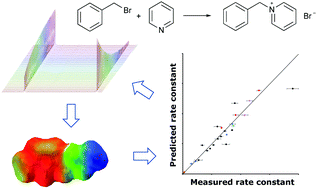Controlling the outcome of SN2 reactions in ionic liquids: from rational data set design to predictive linear regression models†
Abstract
Rate constants for a bimolecular nucleophilic substitution (SN2) process in a range of ionic liquids are correlated with calculated parameters associated with the charge localisation on the cation of the ionic liquid (including the molecular electrostatic potential). Simple linear regression models proved effective, though the interdependency of the descriptors needs to be taken into account when considering generality. A series of ionic liquids were then prepared and evaluated as solvents for the same process; this data set was rationally chosen to incorporate homologous series (to evaluate systematic variation) and functionalities not available in the original data set. These new data were used to evaluate and refine the original models, which were expanded to include simple artificial neural networks. Along with showing the importance of an appropriate data set and the perils of overfitting, the work demonstrates that such models can be used to reliably predict ionic liquid solvent effects on an organic process, within the limits of the data set.

- This article is part of the themed collections: Non-traditional solvent effects in organic reactions, Emerging AI Approaches in Physical Chemistry and 2020 PCCP HOT Articles


 Please wait while we load your content...
Please wait while we load your content...